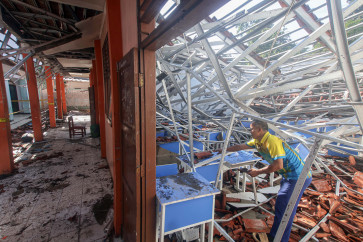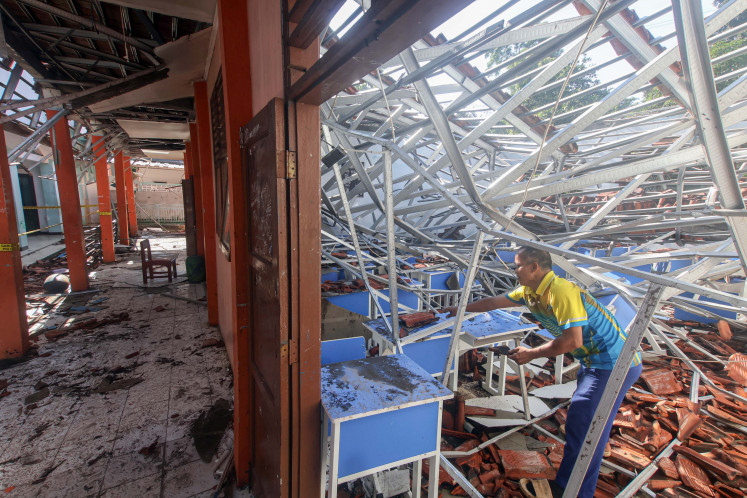Popular Reads
Top Results
Can't find what you're looking for?
View all search resultsPopular Reads
Top Results
Can't find what you're looking for?
View all search resultsExpo 2017 Astana: Kazakhstan’s epitome of structural reform
Imposing: Visitors of the Expo 2017 Astana head toward the exhibition’s central building, the Sphere, on June 10
Change text size
Gift Premium Articles
to Anyone
I
span class="caption">Imposing: Visitors of the Expo 2017 Astana head toward the exhibition’s central building, the Sphere, on June 10. The exhibition, which lasts from June 10 to Sept. 10, is expected to draw as many as 5 million visitors into pavilions run by more than 110 countries and international organizations.(JP/Rendi A. Witular)
It took Kazakhstan less than three years and at least US$3 billion to turn 25 hectares of arid land in its capital Astana into a sprawling iconic exhibition center, the biggest in Central Asia, that now hosts one of the biggest expos on the planet.
Expo 2017 Astana, with the theme of “Future Energy,” opened on June 10, heralding a global call for governments and businesses to take control of fossil-based energy consumption and to minimize damage to the environment.
The expo, which will last until Sept. 10, is expected to draw as many as 5 million visitors into the pavilions run by more than 110 countries and international organizations, amplifying the significance of Astana and its reforms to the global audience.
However, what makes the exhibition and its entailed infrastructure strikingly distinctive is how they personify Kazakhstan’s attempts to embark on an ambitious economic transformation ushered in by President Nursultan Nazarbayev less than three years ago.
From a nation that was once spoiled by its earnings from commodities, particularly oil, Central Asia’s biggest economy is now turning itself into the region’s powerhouse in financial, renewable and IT businesses.
“We’re shifting from the old paradigm where the economy has been largely driven by commodities and old industrialization. The volatility of commodity prices has served as a wake-up call for both the public and the private sector,” Kairat Nematovich Kelimbetov, the governor of the Astana International Financial Centre (AIFC), said recently.
“Believe me it’s very difficult to introduce reform and transformation if oil prices are high,” he said.
Kelimbetov and the AIFC are now spearheading reforms in Kazakhstan’s financial sector and rules for businesses.
President Nazarbayev signed in December 2015 a law establishing the AIFC based on English common law with a preferential tax treatment and independent financial court.
For the first time since the post-Soviet Union era, the principles of English law will operate in Astana’s financial hub with English as the official language of the financial center.
“We are creating a new judicial system for the financial enclave. This includes an independent judicial court and arbitration center. This will be the center of excellence for dispute resolution and fair treatment of investors,” said Kelimbetov.
Based on the success of leading financial centers around the world, such as London, Hong Kong, Dubai and Singapore, the AIFC will also provide unprecedented incentives to attract foreign investors that have not had any exposure to the territory of the former Soviet Union.
Considerable tax exemptions will be provided for 50 years, as well as a simplified monetary, visa and labor regime for investors in the financial center.
The 50-year tax waiver is aimed at corporate tax, individual income tax, property tax and land tax.
In the next couple of months, Kazakhstan will have a new bourse in partnership with the Shanghai Stock Exchange to tap liquidity from Chinese banks. Nazarbayev and China President Xi Jinping witnessed the signing of the cooperation agreement last week.
“Aside from the new stock exchange, the reform will also include privatization of the country’s state enterprises, enforcing the rule of law, fewer government roles and a good quality of civil servants,” said Kelimbetov.
The financial enclave will occupy the Expo 2017 facilities once the exhibition is concluded in September.
“The Expo 2017 infrastructure has the design of an ultra-modern urban district that will bring together scientific, technological and cultural facilities,” Kazakh Invest chairman Maksat Kabashev said.
Aside from financial businesses, the AIFC and Kazakh Invest, a state company set up to attract and support investment, will also embark on an initiative to lure investment into renewable energy and IT startups that include financial technology and cyber security as the country recently forged a cooperation agreement with Israel to develop the sector.
In terms of renewable energy, the AIFC will issue green bonds and tap various financial resources in Europe to finance local companies interested in developing wind turbines and hydro energy in the country where 85 percent of its power plants are fueled by coal while the remaining 15 percent are run by hydro power.
Just two months ago, Kazakhstan upgraded its investment promoting agency to have a supporting authority and rebranded it Kazakh Invest in order to attract investment to the new sectors.
The company is authorized to implement measures of state support for industrial and innovative activities in attracting foreign investment, as well as export development and promotion. It is also providing one-stop services to support investment projects from idea to implementation.
The economic transformation and structural reform are necessary for Kazakhstan for it to keep ahead of the pack in regional competition.
Kazakhstan’s lead in financial, IT and renewable energy businesses will give it an edge to compete in the Eurasian Economic Union, which consists of Kazakhstan, Russia Armenia, Belarus and Kyrgyzstan with a combined market of more than 180 million people.
Kazakhstan’s competitive advantage will strengthen its dominance in Central Asia where 50 percent of the region’s gross domestic product centers on the land-locked country. The region is expected to have more than 70 million people in the next couple of decades.
Aside from that, Kabashev also highlighted Kazakhstan’s strategic position in China’s One Belt One Road initiative.
“We have buckled this belt and have become a key country for China in developing this region. We are in the best position to connect cities in China with the Western world,” said Kabashev.










